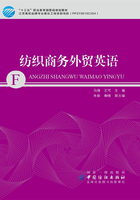
Unit 5 Testing of Fabrics(纺织品检测)
GeneraI tests of Fabrics(纺织品的基本测试)
1.Physical Tests
Common physical tests for fabrics are listed in Tab. 1.17.
Tab. 1.17 Common physicaI tests for fabrics

2.Color Fastness Tests
Common color fastness tests for fabrics are listed in Tab. 1.18.
Tab. 1.18 Common coIor fastness tests for fabrics

3.Chemical Tests
Common chemical tests for fabrics are listed in Tab. 1.19.
Tab. 1.19 Common chemicaI tests for fabrics

4.Accessories Tests
Common accessories tests are listed in Tab. 1.20.
Tab. 1.20 Common accessories tests

Testing Standards
1.Commonly Used Textile Testing Standards
GB is set by Standardization Administration of China and is recognized by China.
FZ is set by China National Textile Industry Council and is recognized by China.
EN is set by CEN/CENELEC(European Committee for Standardization/European Committee for Electrotechnical Standardization)and is recognized by European countries.
AATCC is set by American Association of Textile Chemists and Colorists and is recognized by A-merican countries.
ASTM is set by American Society for Testing and Materials and is recognized by American coun-tries.
AS is set by Standards Australia and is recognized by Australia and New Zealand.
BS is set by British Standards Institution and is recognized by Britain.
CAN/CGSB is set by Canadian General Standards Board and is recognized by Canada.
DIN is set by Deutsches Institut für Normung e.v.and is recognized by Germany.
FTMS is set by the United States Government and is recognized by the United States.
ISO is set by International Organization for Standardization and is recognized by European coun-tries.
IWS is set by International Wool Secretariat and is recognized by most countries in the world.
JIS is set by Japanese Standards Association and is recognized by Japan.
NF is set by Association Francaise De Normalissation and is recognized by France.
US CPSC is set by the US Consumer Product Safety Commission and is recognized in the United States.
2.Famous Third Party Textile Inspection Organizations
Famous third party textile inspection organizations, such as SGS(http://www. sgsgroup.com.cn),BV(Bureau Veritas, http://www.bureauveritas.cn),ITS(http://www.intertek.com.cn),PONY(http://www.ponytest.com),CTI(Centre Testing International, http://www.cti-cert.com),TUV Rheinland(https://www.tuv.com/greater-china/cn/),can provide the world′s lead-ing inspection, verification, testing and certification services.They are recognized as the global benchmark for quality and integrity.
Care LabeIs(防护标签)
Care labels can help consumers make buying decisions based on the providing information as well as clarify the care method. Labels on textile products should include the following basic information.Fig.1.45 shows some care labels of textile products.Name and address of the manufacturer, name of the product, modal number of the product, size of the product, product composition, quality grade, safety grade, washing instructions, storage conditions and other recommendations, and applicable standards are induded.

Fig.1.45 Care labels of textile products
Vocabulary
adequate 充足的
influence 影响
claim 声称,断言
instruction 指导,教导
ullage 损耗
validate 验证
transference 转移
adjacent 相邻,邻近的
qualitative 定性的
quantitative 定量的
formaldehyde 甲醛
residue 残余物
organochlorine 有机氯
pesicide 农药
ecological 生态(学)的
ban 禁止,禁令
identification 鉴定,识别
extractable 可提取的
accessory 附件,辅料
benchmark 基准
integrity 诚信
clarify 阐明,澄清
Professional Vocabulary
tear strength 撕裂强力
bursting strength 顶破强力,胀破强力
bonding strength 黏合强力
seam strength 接缝强力
seam slippage 接缝滑移
stitch density 线圈密度(针织物)
dimensional stability 尺寸稳定性
skewness 纬斜
moisture regain 回潮率
flammability 可燃性
color fastness to crocking 聚合耐摩擦牢度
color fastness to chlorine bleach 耐氯漂牢度
color fastness to oxidation bleach 耐氧漂牢度
color fastness to hot pressing 耐热压烫色牢度
AZO dyes 偶氮染料
yellowing 变黄
whiteness 白度
zipper strength 拉链强力
durability of zipper 拉链耐用性
attachment of snap 纽扣附着力
Translation Practice
1.Washing Instructions

Continued

Continued

Continued

Continued

2.Care Labels
(1)Pillow(Fig.1.46)

Fig.1.46 Pillow

(2)Socks(Fig.1.47)

Fig.1.47 Socks

(3)Skirt(Fig.1.48)

Fig.1.48 Skirt

(4)Shirt(Fig.1.49)

Fig.1.49 Shirt
